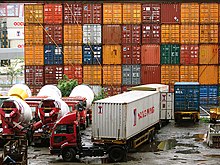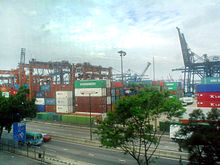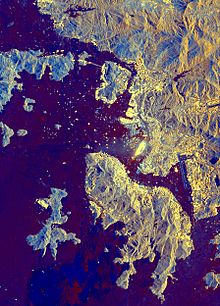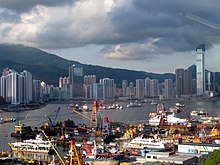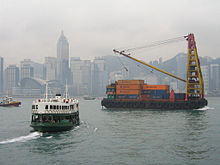
Maritime transport or more generally waterborne transport, is the transport of people (passengers) or goods (cargo) via waterways. Freight transport by sea has been widely used throughout recorded history. The advent of aviation has diminished the importance of sea travel for passengers, though it is still popular for short trips and pleasure cruises. Transport by water is cheaper than transport by air or ground, but significantly slower for longer distances. Maritime transport accounts for roughly 80% of international trade, according to UNCTAD in 2020.

A port is a maritime facility comprising one or more wharves or loading areas, where ships load and discharge cargo and passengers. Although usually situated on a sea coast or estuary, ports can also be found far inland, such as Hamburg, Manchester and Duluth; these access the sea via rivers or canals. Because of their roles as ports of entry for immigrants as well as soldiers in wartime, many port cities have experienced dramatic multi-ethnic and multicultural changes throughout their histories.

Kwai Chung is an urban area within Tsuen Wan New Town in the New Territories of Hong Kong. Together with Tsing Yi Island, it is part of the Kwai Tsing District of Hong Kong. It is also part of Tsuen Wan New Town.
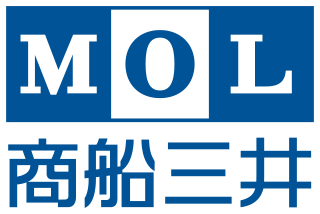
Mitsui O.S.K. Lines is a Japanese transport company headquartered in Toranomon, Minato, Tokyo, Japan. It is one of the largest shipping companies in the world.

APL, formerly called American President Lines Ltd., is an American container shipping company that is a subsidiary of French shipping company CMA CGM. It operates an all-container ship fleet, including nine U.S. flagged container vessels.

China Ocean Shipping Company, Limited, formerly China Ocean Shipping (Group) Company, commonly known for its abbreviated name COSCO Group, or simply, COSCO, is one of the major holding companies for COSCO Shipping, one of the world's largest shipping companies. COSCO Shipping was formed in January 2016 by a merger of COSCO and China Shipping Group as one conglomerate.

The Port of Singapore refers to the collective facilities and terminals that conduct maritime trade, and which handle Singapore's harbours and shipping. It has been ranked as the top maritime capital of the world, since 2015. Currently the world's second-busiest port in terms of total shipping tonnage, it also transships a fifth of the world's shipping containers, half of the world's annual supply of crude oil, and is the world's busiest transshipment port. It had also been the busiest port in terms of total cargo tonnage handled until 2010, when it was surpassed by the Port of Shanghai.

Evergreen Marine Corporation is a Taiwanese container transportation and shipping company that is headquartered in Luzhu District, Taoyuan City, Taiwan. With over 150 container ships, it is part of the Evergreen Group conglomerate of transportation firms and associated companies.

The Marine Department of the Hong Kong Government is responsible for maintaining safety and environmental protection of the harbour, ships registered/foreign ships in Hong Kong and monitor shipping traffic in Hong Kong Waters, search and rescue operations for large waters of the South China Sea.

Zim Integrated Shipping Services Ltd., commonly known as ZIM, is a publicly held Israeli international cargo shipping company, and one of the top 20 global carriers. The company's headquarters are in Haifa, Israel; Originating in 1945, ZIM has traded on the New York Stock Exchange since 2021. From 1948 to 2004, it traded as ZIM Israel Navigation Company.

Kwai Tsing Container Terminals is the main port facilities in the reclamation along Rambler Channel between Kwai Chung and Tsing Yi Island, Hong Kong. It evolved from four berths of Kwai Chung Container Port completed in the 1970s. It later expanded with two berths in the 1980s. Two additional terminals are added adjoining to Stonecutters Island in the 1990s and was renamed Kwai Chung Container Terminals. In the 2000s, Container Terminal 9 on the Tsing Yi Island was completed and the entire facility was renamed to Kwai Tsing Container Terminals.
The Port of Montreal is a cruise and transshipment point. It is located on the St. Lawrence River in Montreal, Québec, Canada. The port operates as an international container port. It services Toronto, the rest of Central Canada, the Midwestern United States, and the Northeastern United States. Though found on the Saint Lawrence Seaway, it is some 1,600 miles (2,600 km) inland from the Atlantic Ocean and it is on the shortest direct route between the North American Midwest and Europe or the Mediterranean.
Port of Guangzhou is the main seaport of Guangzhou city, Guangdong province, China. The port is operated by Guangzhou Port Group Co. Ltd which is a state owned company. The company was established on February 26, 2004 from the former Guangzhou Harbor Bureau. It was approved by the Guangzhou Municipal Government. It is currently the largest comprehensive port in South China. Its international maritime trade reaches over 300 ports in more than 80 countries and districts worldwide. The port also incorporates the former Huangpu Port.

The Port of Xiamen is an important deep water port located on Xiamen Island, the adjacent mainland coast, and along the estuary of the Jiulong River in southern Fujian, China. It is one of the trunk line ports in the Asia-Pacific region. It is ranked the 8th-largest container port in China and ranks 17th in the world. It is the 4th port in China with the capacity to handle 6th-generation large container vessels. In 2013, Xiamen handled 191 million tons of cargo, including 8.08 million TEUs of containers. On 31 August 2010, Xiamen Port incorporated the neighboring port of Zhangzhou to form the largest port of China's Southeast. This was a relatively uncommon case of ports merging across jurisdictions.

The Port of Busan is the largest port in South Korea, located in the city of Busan, South Korea. Its location is known as Busan Harbor.
The Port of Qingdao is a seaport on the Yellow Sea in the vicinity of Qingdao (Tsingtao), Shandong Province, People's Republic of China. It is one of the ten busiest ports in the world.

In 1961 China established a state-run maritime shipping company and subsequently signed shipping agreements with many countries, laying the foundation for developing the country's ocean transport. That organization developed into the present-day China Ocean Shipping (Group) Company (COSCO). The Chinese government also invested heavily in water transport infrastructure, constructing new ports and rebuilding and enlarging older facilities.
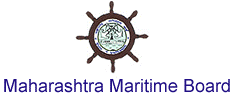
The Maharashtra Maritime Board is governmental organisation in the state of Maharashtra, India. The board is tasked with the administration of ports and harbours, conservancy, licensing of crafts, levying of fees, regulation and control of traffic. Maharashtra Maritime Board (MMB) came into existence in 1996 and Commissioner, Water Transport was re-designated as chief executive officer, MMB.


